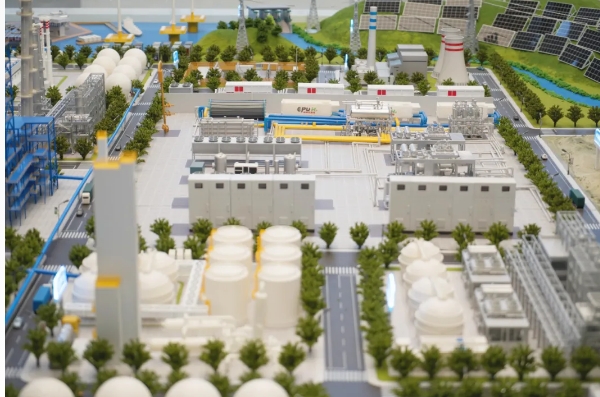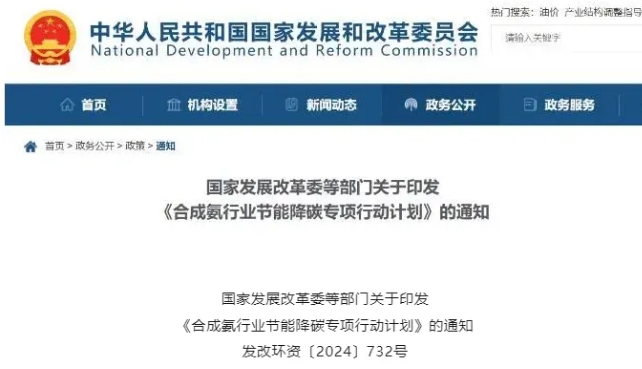Green Hydrogen Consumption Expands! Ammonia industry speeds up carbon reduction under
Time:2024/7/15 Tag:Ammonia, green hydrogen, traditional industry, carbon reduction special action plan, pathway, consumption
In light of the growing global focus on clean energy and low-carbon technologies, the ammonia industry is also witnessing the emergence of new development prospects. On June 7, the National Development and Reform Commission and other relevant departments unveiled a special action plan for energy saving and carbon reduction in the iron and steel, oil refining, ammonia, and cement industries, with the aim of further delineating the trajectory of energy saving and carbon reduction in the aforementioned sectors. Green hydrogen, a form of clean energy generated through the electrolysis of water using renewable energy sources, is being utilized in an increasing number of industries. The ammonia synthesis sector is poised to become one of the primary consumers of hydrogen.

-
Replacing Gray Hydrogen - The Way to Reduce Carbon in Ammonia
China's current synthetic ammonia production stands at 59.092 million tons, with coal-based ammonia accounting for 75.5%, natural gas-based ammonia accounting for 21.4%, and green ammonia prepared by new energy accounting for a relatively low percentage. Despite the delayed commencement of domestic green ammonia industrialization, the pace of development has been rapid and the availability of sufficient power has been a key factor. Since 2021, over 30 green ammonia projects have been announced in China, with a collective planned production capacity in excess of 4 million tons.
The direct utilization of green hydrogen for ammonia production circumvents the occurrence of the water gas shift reaction and realizes zero carbon emission at the hydrogen production end, which has significant potential for emission reduction. The production of all of China's current synthetic ammonia using green hydrogen could result in a reduction of carbon emissions by over 100 million tons.
Furthermore, the utilisation of green hydrogen can circumvent the consumption of fossil raw materials, such as coal and natural gas. It is estimated by some organizations that if all synthetic ammonia in China were produced using green hydrogen, there would be a reduction in coal consumption of approximately 50 million tons per year.
In the context of the dual-carbon policy, the synthesis of green ammonia using renewable energy has been developed rapidly. Theoretically, for every 1 ton of green ammonia produced, 0.18 tons of green hydrogen are consumed, and the costs associated with electricity and equipment investment represent a significant portion of the overall costs involved in the production of green ammonia, which currently stands at approximately RMB 3,500 per ton.
-
From Green Hydrogen to Green Ammonia - Achieving "Mutually Reinforcing" Development
Green hydrogen is defined as hydrogen produced through the use of renewable energy sources, such as wind, hydropower, and solar power, as well as biomass hydrogen production. The production process does not result in the emission of greenhouse gases such as carbon dioxide, thereby ensuring that the production of green hydrogen is zero-emission.
As a significant application of hydrogen, ammonia plays a crucial role in the consumption of hydrogen, representing one of the primary avenues for its utilization.
Ammonia is a significant raw material utilized in the production of nitric acid, fertilizers, and explosives. Ammonia is a vital component for life on Earth, serving as a fundamental element in food and fertilizers, as well as a direct or indirect component in medicines.
Ammonia (or methanol) is a versatile carrier with a mature technology for large-scale storage and transportation, which has made it an ideal choice for the large-scale export of green hydrogen from numerous ports in regions with abundant green energy, including Australia, Chile, and Saudi Arabia. The next breakthroughs needed in the preparation of green hydrogen for green ammonia are mainly concerned with the fluctuation of renewable energy supply and consumer demand in the green ammonia market. In addition, operational safety and process economics must be given full consideration, as must the catalyst kinetic mechanism under complex and variable working conditions, the ammonia synthesis process flow technology adapted to flexible production, and so on.
-
Carbon Reduction Speeds Up - Driving Green Hydrogen Consumption Expansion
On June 7, the National Development and Reform Commission and five other departments issued a notice regarding the "synthetic ammonia industry energy saving and carbon reduction special action plan." This notice outlines clear targets for the synthetic ammonia industry, stating that by the end of 2025, the energy efficiency benchmark level of production capacity must exceed 30% and that any production capacity below this level must complete technological transformation or be phased out. By the conclusion of the 14th Five-Year Plan in 2025, the proportion of production capacity exceeding the energy-efficiency benchmark level is to be increased to 30%. In parallel, production capacity below the energy-efficiency benchmark level is to be either technologically reformed or phased out.

By the conclusion of 2030, the proportion of production capacity exceeding the energy-efficiency benchmark threshold within the ammonia industry will have undergone a further increase. Additionally, the utilization efficiency of energy resources will have reached the international advanced level, the proportion of green electricity and green hydrogen consumption within the production process will have been significantly enhanced, and the green and low-carbon development of the ammonia industry will have achieved notable outcomes.
It is recommended that low-carbon raw materials be substituted in the production of synthetic ammonia, including the prohibition of the use of high-sulfur petroleum coke and the encouragement of the combination of renewable energy power generation and synthetic ammonia enterprises. In principle, no additional captive coal-fired units will be installed in new ammonia projects. However, support will be provided for clean energy substitution measures for existing captive coal-fired units. The promotion of renewable energy as a replacement for coal-based hydrogen production will result in an enhanced utilization ratio of green hydrogen.
-
Commitment to Green Hydrogen - Promoting Green Energy Transformation
As a pioneering enterprise specialising in the manufacture of electrolytic water hydrogen production equipment, CPU Hydrogen bears significant responsibility and is entrusted with a pivotal role in facilitating the transition to green energy and the deployment of green hydrogen. The company is dedicated to the development and production of an electrolyzed water hydrogen system that is the most efficient in the world, with the objective of providing safe and reliable equipment to support the hydrogen production market.
In November 2023, the CPU Hydrogen Enterprise Science Association was formally established. It was voluntarily formed by the company's science and technology workers and has become an important force in promoting the company's scientific progress and technological innovation. By fostering enthusiasm for scientific research, CPU Hydrogen has innovated five generations of electrolyzer structures in less than three years of research and development. The company has also solved the industry's "choke points," including electrode catalysts and diaphragm materials, and has significantly enhanced the efficiency of electrolyzers.
Since its establishment, CPU Hydrogen has participated in over ten industry-related academic conferences and technical forums, engaging in discourse with international scholars and experts at the highest levels of their respective fields. Additionally, the company has expanded its reach to key hydrogen energy markets worldwide, including the Middle East, Europe, and North Africa, in order to gain a deeper understanding of the industry's actual needs.
In the future, CPU Hydrogen will assume a pioneering role in scientific and technological self-reliance and self-improvement. It will continue to enhance its independent R&D and innovation capabilities and expand into new application fields, including green ammonia, green methanol, and hydrometallurgy. This will enable the company to proactively shape the future trajectory of the industry.

